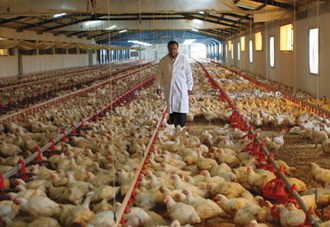 The evolution of bird flu
The evolution of bird flu
Q: Q uestion for population biologist Robert Mauck: Not a day goes by that we don't read a news article about bird flu, whether it concerns new cases being discovered or preparations being made--or not being made--in case a human pandemic arises. How likely are we to see a pandemic on the scale of what happened in 1918? How worried should we be?
A: If and when the bird flu virus transmutes into something that can easily spread among humans, we'll have quite a lot to worry about. Right now, the virus is mainly a threat to birds. We've seen it infect cats and humans, often lethally, but it hasn't yet switched hosts in such a way that it can pass from person to person to person.
In the 1918 pandemic, which is our best model, the flu moved through areas very quickly, killing a lot of people in a short amount of time and moving on. Those people who were susceptible were gone; the ones who weren't survived. The survivors had a resistance to it that was passed on to their offspring. Once they survive the selection process, the virus doesn't have as many susceptible hosts.
We've already seen with the current flu that mortality rates are very uneven among countries. In Thailand, twelve out of thirteen humans who contracted the virus died. In other countries, the death rate is zero out of six. It may be that some populations are genetically better fitted to survive this disease than others.
At this point, bird flu is limited to what's geographically called the Eastern Hemisphere: that great swath of the world that stretches from China to Spain. As waterfowl migrate, they often stop in places where they mix with domestic waterfowl and poultry. A likely scenario is that the virus then spreads locally, as infected poultry are transported to markets. Could birds bring it here? Migratory birds breeding in eastern Siberia could bring the flu into our hemisphere if they cross over into Alaska.
On the Atlantic side, only ocean-going pelagic sea birds could travel the distance from the Eastern Hemisphere to the coast of North America. I study pelagic sea birds that spend the winter off the coast of Africa and breed in an island off the coast of Maine, and I can tell you that those birds don't intermingle with birds now known to carry bird flu. So I believe that bird flu is not highly likely to get here through birds. It's more likely that if it becomes spreadable among humans in Asia, Europe, or Africa, the travel of humans would then bring it here.
My students and I handle birds all the time. If a single case of bird flu appears in the Western Hemisphere, I would worry about the safety of my students. At the least, we would take special precautions in collecting samples, such as wearing latex gloves and masks. Washing hands is something everybody should do during flu season, regardless.
Some people say that there's nothing to worry about, because this virus has been around since 1997, it's had time to change and it hasn't. Don't take their word for it, because if they're wrong, the consequences are dire. What we're talking about is the evolution of a virus. It seems to me the probability is that it will make the jump to humans sometime.
Robert Mauck is the Harvey F. Lodish Faculty Development Professor in the Natural Sciences. Mauck researches physiological, environmental, and behavioral influences on birds' success as breeders and survivors. Mauck does much of his work at the Bowdoin Scientific Station at Kent Island in New Brunswick, Canada, where he serves as director.
Do you have feedback on this page?
